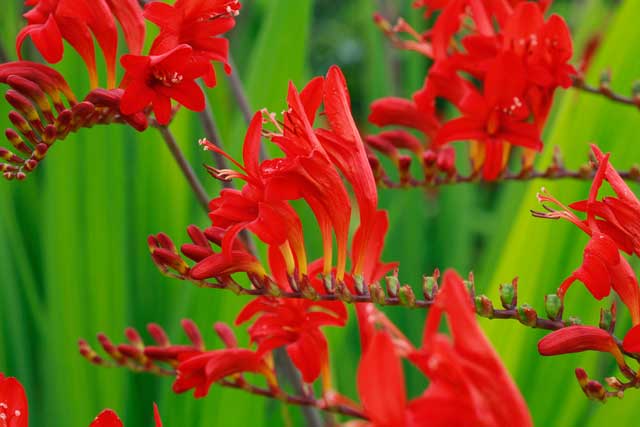Give the devil his due: 'Lucifer' has never looked more appealing

Last summer I went on a guided garden walk of Elephant & Castle, one of south London's most, ahem, "improving" neighbourhoods. The tour was conducted by Richard Reynolds, "guerrilla gardener" and long-time local resident. He showed us round a whole range of wastegrounds and roundabouts he'd planted up at night alongside his fellow horticultural commandos, before proceeding to out himself as a simple Devon lad by pointing out a big clump of what he called "montbretia" growing at the foot of a high-rise, which he'd dug up from his mum's garden.
These days only West Country folk still call it montbretia, because the rest of us have been to stern re-education camps where we've learnt to use the word "crocosmia" for these arching, fiery-coloured South African plants that delight the eye in high summer. (The science boffins changed the name for, you know, science reasons.) But whatever you call it, one fishing-rod stem of green supports perfectly balanced squiggles of orange, yellow or red, angled just right for the birds which pollinate the plant in the wild.
As in the case of Elephant & Castle, much work has been done to improve crocosmia. Coming from the vicinity of East London (in South Africa, mind) the original, sturdy orange-flowered plant is so persistent that in some parts of the world it is considered a serious weed. However, it is a fairly particular weed, requiring rich soil and summer moisture to really flourish – which explains its ubiquity in the West Country.
Crocosmia still really comes only in strong colours. If your garden is mostly "tasteful", you will have to restrict yourself to the palest yellow varieties, such as the excellent "Honey Angels" with a touch of cream (order three bare-rooted plants for autumn delivery for £9.95 from mr-fothergills.co.uk), or "Solfatare", with delicious bronze foliage (£7.99 for 2-litre pot from crocus.co.uk).
But if you're happy with hot oranges and reds for August and September, it's a wonderfully architectural, space-filling plant that complements bigger shrubs such as hydrangea quite happily.
Most famous of all the red crocosmias is "Lucifer", a huge, arching plant that forms a proper clump and zings out from the back of a group of plants. (One plant from crocus.co.uk goes for £7.99.)
Each crocosmia differs slightly in flowering season, so that with care you can have them in bloom for most of the summer. "Lucifer" is already on the go in my garden, but there are later crocosmias, too, such as the lovely "Queen Mary II", with its purple buds opening to golden flowers, or the vivid orange of "Emily McKenzie" (£7.99, crocus.co.uk). Or take a lucky dip, with Westcountry Lupins' "five of our choice" offer for £20 (west countrylupins.co.uk). Or try it from corms in spring, from Avon Bulbs or Broadleigh Gardens, which both have small but select lists. Just don't call it montbretia. 1
Croc and awe
Allan Armitage has just published a fully updated edition of Armitage's Garden Perennials, his invaluable compendium of the best varieties for garden growers (£30, Timber). Here are his expert crocosmia tips...
1. Reds
"Walberton Red" is almost as good as "Lucifer", and its smaller stature is useful where "Lucifer" can get out of hand. One plant for £3.50 from Cornwall's trecanna.co.uk
2. Yellow
"Rowallane" has been around for some time and is a handsome addition to the garden. £8.50 for a larger pot from Trecanna
3. Orange
The compact "Star of the East" offers many handsome orange-yellow flowers. £7.99, crocus.co.uk
Join our commenting forum
Join thought-provoking conversations, follow other Independent readers and see their replies
Comments
Bookmark popover
Removed from bookmarks